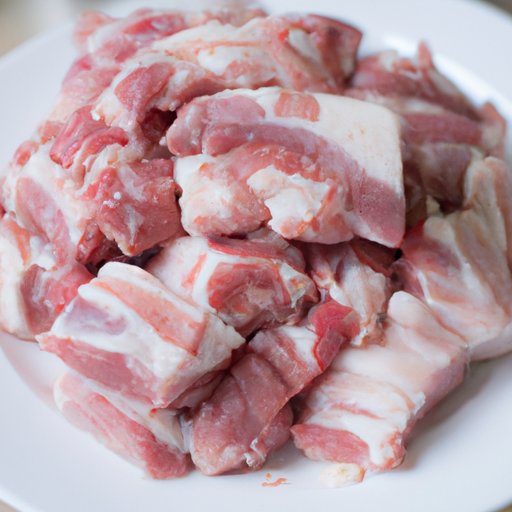
Introduction
When it comes to food safety, knowing what and how to cook is crucial to avoid potential health hazards. While many people enjoy dishes with raw meat such as sushi or ceviche, the question of whether or not it is safe to eat raw pork is a contentious issue. In this article, we will delve deeper into this topic and explore the risks and facts surrounding raw pork consumption.
The Risks of Eating Raw Pork: What You Need to Know
Raw pork refers to uncooked or undercooked pork meat. Although it might seem like a preference or delicacy in some cultures or cuisines, it can pose serious health risks due to the presence of bacteria, viruses, or parasites. One of the most common diseases associated with consuming raw pork is trichinosis, caused by a parasitic worm that can infect both animals and humans. Symptoms can range from mild to severe, including abdominal pain, diarrhea, muscle pain, and even death. Other foodborne illnesses that can result from consuming raw pork include E. coli, Salmonella, and Campylobacter.
According to CDC, approximately one million people get sick from consuming contaminated pork in the United States each year. It is important to note that cooking pork thoroughly can kill bacteria or parasites that cause these infections.
Why Raw Pork Should be Avoided: A Guide to Safe Cooking
To reduce the risks associated with consuming raw pork, it is recommended to cook pork to an internal temperature of 145 degrees Fahrenheit. According to the USDA, pork can still have a pink hue but be considered safe to eat as long as it reaches the appropriate temperature. It is also essential to avoid cross-contamination by separating raw pork from other foods, washing hands and utensils frequently, and refrigerating or freezing leftovers promptly.
The Truth About Raw Pork: Myth or Fact?
Due to cultural or personal preferences, many myths and misconceptions surround the consumption of raw pork. For example, some people believe that freezing pork can kill all harmful bacteria or that it is a natural part of the animal’s anatomy. However, research shows that freezing pork does not eliminate all risks and that cooking is the only reliable way to prevent foodborne illnesses. Moreover, the commensal flora and enzymes in pork can also be harmful to humans if ingested raw or undercooked.
Raw Pork: Delicious or Dangerous?
Despite the possible dangers of consuming raw pork, it remains a popular ingredient in many dishes around the world. For example, the Japanese dish called Tonkatsu is made with raw pork that has been marinated in vinegar and spices, whereas the French dish Tartare is prepared with ground raw beef. However, it is essential to weigh the risks and benefits of consuming raw meat and to ensure that the appropriate safety measures are taken, such as sourcing high-quality meat from reputable suppliers and storing it properly.
To Cook or Not to Cook: A Raw Pork Dilemma
In many situations, people face a dilemma when deciding whether or not to cook their pork. Imaginary scenarios include people forgetting to cook their pork after marinating it or wanting to impress a date with a raw pork dish. However, it is essential to consider the potential health risks of consuming raw pork and the importance of safe cooking practices. In the end, the outcome may not be the one expected, as humorously portrayed in this section.
What to Do When You Accidentally Eat Raw Pork
If despite precautions someone ends up consumig raw pork, they should contact a healthcare professional if they experience any symptoms such as nausea, vomiting, or diarrhea. Treatment might include medication or therapy, depending on the severity of the illness. Monitoring their conditions and maintaining a healthy, balanced diet after they have recovered is also important.
From Sushi to Tartare: Exploring Different Raw Meat Dishes
Raw meat dishes are not exclusive to pork. Some popular examples include sushi, a Japanese cuisine dish made with raw fish, and ceviche, a South American dish of raw seafood marinated in citrus juices. Like raw pork, these dishes have their risks and safety guidelines, such as sourcing fresh, high-quality ingredients and ensuring proper refrigeration. It is up to the individual to decide whether or not the potential health risks are worth the experience and to take appropriate precautions.
Conclusion
When it comes to raw pork consumption, it is important to be aware of the potential risks associated with it and to take appropriate precautions, such as safe cooking practices and proper meat handling and storage. While some cultures and cuisines enjoy raw pork dishes, it is essential to weigh the benefits and risks of consuming raw meat. Remembering the informative guidelines provided in this article should help you weigh the risks and benefits of consuming raw pork without risking your health.




